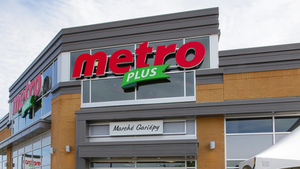RIDING THE LOCAL
More retailers are using micromarketing as a tool to sharpen their competitive edge. Ahold, Zaandam, Netherlands, is one such company. To meet the changing needs of its customers, it has developed a new vision for its organization and its range of product and service offerings, according to its 1995 annual report."The modern family has fewer members, each with his or her own consumption pattern. Standards
March 24, 1997
AMITY K. MOORE
More retailers are using micromarketing as a tool to sharpen their competitive edge. Ahold, Zaandam, Netherlands, is one such company. To meet the changing needs of its customers, it has developed a new vision for its organization and its range of product and service offerings, according to its 1995 annual report.
"The modern family has fewer members, each with his or her own consumption pattern. Standards and values are becoming more divergent per family and per customer," the report said.
Ahold launched frequent-shopper card programs in its Finast Friendly Markets and Tops Friendly Markets stores, which are two supermarkets leading the micromarketing pack, a consultant told SN. These shopper cards and programs provide grocers with information specific to each of their customers -- for instance, which Center Store products they buy and how frequently they shop the store. With the exception of forwarding a section of its annual report, Ahold declined to comment on its micromarketing program.
Landover, Md.-based Giant Food does not have a frequent-shopper card, but Dave Herriman, senior vice president of grocery operations, agreed that such programs are beneficial.
"One of the reasons for developing those types of programs is that you can micromarket to a given area," Herriman said.
Herriman added that retailers can also target a particular type of consumer -- the elderly, single shoppers, large families or married couples, for example.
Herriman suggested soliciting demographic data from the U.S. Census Bureau. This information offers grocers an opportunity to look into the income level, age, population density and ethnicity of its consumer base. Information is available on-line through the Census Bureau's web site: http://www.census.gov.
K.V. Mart Co., Carson, Calif., targets ethnic shoppers, buys demographic data and breaks it out by ZIP code, said George Matics, the company's assistant director of purchasing and merchandising.
The retailer recently added ethnic-specific grocery sections featuring foods from Mexico, Cuba, Central America, Asia and the Middle East. Items include jarred sauces, sauce mixes and bags of rice.
"We refine [the data] the old-fashioned way. We walk and drive the neighborhoods and we find the nearest school to observe the makeup of the children there," Matics added.
K.V. Mart also hires from local neighborhoods. "That gives us great insight as well," Matics said.
Micromarketing is revolutionizing the way retailers think about their customers. By transferring marketing energies from a mass perspective to a niche market, grocery operators are realizing better margins and more effective promotional spending -- and hoping to expand their market share.
Micromarketing ties into the industry's trend toward efficiency. In 1995, for instance, only 14% of retailers were allocating similar shelf space for all store locations, a 17% drop from the previous year's response, according to the recently released 18th Annual Survey of Promotional Practices produced by Carol Wright Promotions, Naperville, Ill.
The survey, based on 1995 data, also revealed that of the retailers currently building a consumer database last year -- often through card-based programs -- 86% planned to use their databases for customer/shopper research. Almost half, 43%, planned to use the information base to plan their store merchandise, and 86% said they would apply the information to customer continuity/frequent-shopper programs.
"The more economic use of spending and target spending makes more sense. [The concept] allows for better return on your spending," said Doug Domine, director of grocery marketing, Nash Finch Co., Minneapolis.
Herriman, who said Giant is gathering its resources to implement a program, added that micromarketing is proving to be "the most efficacious way of spending your money."
He admitted the process is labor intensive for his chain. For supermarket companies that own many stores in several regions, micromarketing can be difficult.
To ease the transition from mass marketing to a more efficient strategy, Herriman said larger chains address a cluster of four or five stores that have a similar profile within a particular area, instead of an individual store. This tactic simplifies ordering and distribution systems.
"[Micromarketing] is taking the retailer from the prehistoric method of sorting stores by price zones to the next century's version of segmenting stores based on the consumer population that lives within a store's specific trading area," added Burt Flickinger 3rd, managing director of retail reach at Retail Reach Marketing, a Westport, Conn.-based consulting firm.
Matics of K.V. Mart said micromarketing was one way he found to better compete against not only alternative formats, but also the larger chains, like Vons and Lucky's, in his area. The concept allows him to customize his item selection on a per store basis, "targeting the specific ethnic makeup of the neighborhood surrounding each store," Matics said.
While other stores may micromarket to Hispanics, Matics said that segment is his primary shopper. When micromarketing, K.V. Mart focuses on attracting Caribbeans, Samoans, Cambodians, Persians, Armenians and El Salvadorans.
By displaying and running ads in the independent's circular for 10-pound cans of salted corn beef, the stores expect to attract Samoans and other Pacific Islanders.
More crucial, however, is word-of-mouth advertising, according to Matics."That's much more important than what we do in newspapers," he said.
Although Giant is still investigating a full-fledged micromarketing program, Herriman said the chain micromarkets on a smaller level by running ads of locally produced items. He offered Turkey Hill ice cream as an example. Giant stores in New Jersey will emphasize this locally made product through marketing and advertising targeted to local residents,
Michele Swedick, president of Marketing Associates, Albany, N.Y., said that Kosher, Hispanic, Indian, Italian, Polish, natural and specialty categories are some of the more popular ones with retailers who are micromarketing.
She added that micromarketing is necessary if a supermarket is going to survive the competition.
"With more and more 'specialty-specific' stores opening daily -- pet stores, natural supermarkets, ethnic stores, home-meal replacement franchises -- supermarkets must react to protect their volume," she said.
About the Author
You May Also Like




